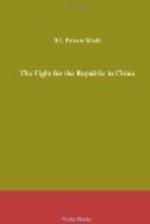It was in Petrograd that this account was liquidated. The extraordinary chapter which only closed with the disastrous Peace of Portsmouth opened for Russia in a very brilliant way. The presence in Moscow of the veteran statesman Li Hung-chang on the occasion of the Tsar’s Coronation afforded an opportunity for exhaustively discussing the whole problem of the Far East. China required money: Russia required the acceptance of plans which ultimately proved so disastrous to her. Under Article IV of the Treaty of Shimonoseki (April, 1895) China had agreed to pay Japan as a war-indemnity 200 million Treasury taels in eight instalments: that is 50 million taels within six months, a further 50 millions within twelve months, and the remaining 100 millions in six equal instalments spread over seven years, as well as an additional sum of 50 millions for the retrocession of the Liaotung Peninsula.
China, therefore, needed at once 80 million taels. Russia undertook to lend her at the phenomenally low rate of 4 per cent. the sum of L16,000,000 sterling—the interest and capital of which the Tsar’s Government guaranteed to the French bankers undertaking the flotation. In return for this accommodation, the well known Russo-Chinese Declaration of the 24th June (6th July), 1895, was made in which the vital article IX states that—“In consideration of this Loan the Chinese Government declares that it will not grant to any foreign Power any right or privilege of no matter what description touching the control or administration of the revenues of the Chinese Empire. Should, however, the Chinese Government grant to any foreign Power rights of this nature, it is understood that the mere fact of having done so will extend those rights to the Russian Government.”
This clause has a monumental significance: it started the scramble in China: and all the history of the past 22 years is piled like a pyramid on top of it. Now that the Romanoffs have been hurled from the throne, Russia must prove eager to reverse the policy which brought Japan to her Siberian frontiers and which pinned a brother democracy to the ground.




